 |
Astronomy 101 Problem Set #1 |
 |
This Problem Set is due by 1:00 pm on Thursday, 1 September
 |
Astronomy 101 Problem Set #1 |
 |
This Problem Set is due by 1:00 pm on Thursday, 1 September
Problem #1: Some of the oldest Moon rocks found by the Apollo missions are estimated to be about 4.45 billion years old. Calculate their age in seconds, and express the result in scientific notation (Use the relation 1 year = 365.25 days).
Problem #2: For many of you, the metric system is fairly unfamiliar. Since ALL of science (and nearly ALL commerce outside the US) makes use of the metric system, it would be a really good idea for you to have some comfort with the units. With that in mind, let's consider a few familiar objects and activities. For each question below, estimate the answer, and express that answer in metric units.
Problem #3: It is claimed that Superman is faster than a speeding bullet. A speeding bullet has a speed of about 700 m/s, so let's assume Superman can fly at 1000 m/s. At this speed, how long would it take him to circle the Earth, a trip of approximately 40,000 kilometers? Approximately how long would it take Superman to travel to the Moon, a distance nearly ten times greater? Express your answers in hours.
Problem #4: On September 21 or thereabouts, the Sun is positioned directly over the earth's equator. That is, were you to stand on the equator at noon on this day, the Sun would be directly over your head. What is the altitude of the Sun above the southern horizon here in Lewisburg (e.g., 41 degrees north latitude), at noontime on that day? (To answer this question, please draw a diagram of the Earth indicating the positions of equator and Lewisburg, the horizons at these locations, and the sunward direction from each of these locations. Then show the geometrical relations you use to derive a numerical answer.)
